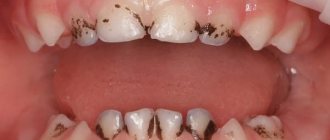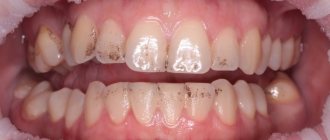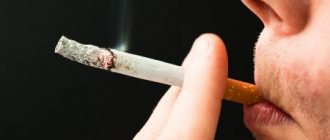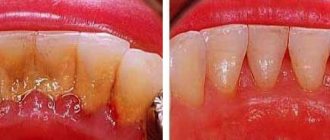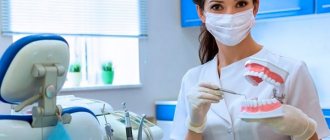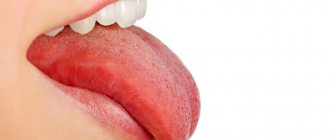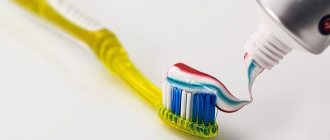What is Priestley's plaque?
Priestley's plaque is dark stains on children's baby teeth, which are a consequence of the activity of certain types of bacteria.
The appearance of a dark, almost black plaque on a child’s teeth can be observed at any age - both at one year old and at an older age. This is a very common occurrence on baby teeth.
As a result, due to black teeth in children, the smile becomes unattractive, and bad breath often appears.
Priestley's plaque on a child photo
However, it is not the child’s black teeth that should alert parents, but the fact that the appearance of this symptom is a signal that some kind of malfunction has occurred in the baby’s body. And to eliminate it, the first thing you need to do is consult a doctor - a pediatric dentist.
Removal methods at home
Dark formations on teeth represent hardened bacteria, food debris, salts, and inorganic compounds. They settle firmly on the enamel, so you can hardly remove them yourself. There are no ways to get rid of black plaque on teeth at home.
Folk remedies in the form of activated carbon, soda, lemon juice and abrasives are powerless here. Moreover, they can harm the oral cavity, damage mucous tissues and cause infection.
Minor discoloration can be removed with a high abrasive whitening toothpaste (RDA 100 or higher) using an ultrasonic or electric brush.
Causes of black plaque on children's teeth
There are many factors that cause black plaque on baby teeth. It is almost impossible to independently identify the cause, so you need to consult a doctor.
The most common causes of its occurrence are the following:
- Priestley's plaque in a child is the most common cause. This is due to special bacteria that produce a black pigment. It settles on the enamel, but goes away completely with age and almost never transfers to permanent teeth. This phenomenon is not dangerous to health and is considered only an aesthetic problem. Plaque can be removed at the dentist, but after a while it will still return. So you just need to wait until it goes away on its own.
- Caries. An equally common, but much more serious reason, since baby teeth are susceptible to the development of disease. They first turn yellow, black spots and spots appear, after which they turn black. The danger is that the disease will spread to permanent teeth if treatment is not started immediately.
- Dysbacteriosis. This disease can also cause problems with the digestive tract. Often occurs due to poor nutrition of the child, long-term use of antibiotics, and the presence of chronic liver or intestinal diseases.
- Excess iron. Quite often, young children are prescribed iron supplements, which often leads to the appearance of dark deposits on the teeth. At the same time, the color of the plaque can change from black to dark purple or brown.
In addition to the reasons listed, plaque can appear due to a lack of calcium, which certainly affects the teeth first. Sometimes it occurs due to impaired intestinal microflora or as a result of poor heredity - if the child’s parents had the same problem in childhood. In any case, to find out exactly the cause, it is necessary to consult a doctor in a timely manner for examination.
Psychosomatics of caries in children
Children differ from adult patients in their increased emotionality and mobility. Treatment of caries is usually accompanied by feelings of anxiety and fear. Parents need to prepare their child for a visit to the dentist, and doctors need to provide emotional support during the treatment process.
- 1.5-2 years.
The baby's perception is associated with muscle sensations. He is afraid of falls: a sudden lowering of a chair or a bright light can frighten him. Parents go to treatment with their child: they hold hands and sit in a chair together.
- 3-4 years.
Children are sociable. The presence of a parent gives a sense of self-confidence and creates a sense of security.
- 5-6 years.
The child may be in the doctor's office without a parent. His behavior changes: before he wanted to touch everything, now he asks questions.
- 7-10 years.
The child becomes more balanced and can overcome the fear of dental procedures. When communicating with him, it is necessary to emphasize the importance of treatment.
- Adolescence.
It is characterized by hormonal changes in the body and frequent mood swings.
Diagnosis and treatment methods of Priestley plaque
The appearance of black plaque can be the result of various diseases. In order to prevent them from starting and to prevent the development of complications, it is necessary to carry out a number of diagnostic measures. Even if a small spot appears on a tooth, you should visit a doctor and undergo laser diagnostics.
If it is caries, then at an early stage of development it is much easier to cure. In addition, the doctor may prescribe additional tests: blood and urine tests. Depending on the results obtained, appropriate treatment methods are selected:
- If problems with the gastrointestinal tract are identified, it is necessary to review the child’s nutritional system. In this case, a special diet is prescribed and some foods are excluded from the diet.
- Lack of calcium or excess iron can be easily treated by taking corrective medications and eating certain foods in greater or lesser quantities.
- When identifying caries at an early stage , dental procedures such as silver plating or fluoridation can help. The doctor treats the teeth with a special solution, which helps prevent further development of the disease and wait for healthy permanent teeth.
- Common Priestley plaque can be removed by professional cleaning by a doctor. But, unfortunately, this is not a guarantee that it will not appear again after a while.
If stains or plaque on the teeth cause pain or discomfort to the child, fillings are used to preserve the teeth and eliminate discomfort.
Causes of darkening of teeth
Why do my child's teeth turn black? This process can be caused by several reasons:
- early caries;
- poor absorption of calcium by the body;
- plaque;
- insufficient salivation;
- hereditary factors;
- chronic diseases;
- fungus of the gastrointestinal tract;
- dysbacteriosis;
- the predominance of foods containing large amounts of sugar in the diet;
- disturbance of fluoride metabolism;
- metabolic disease;
- parents sharing cutlery with their children, licking the child's pacifier or kissing on the lips;
- taking medications containing iron;
- insufficient formation of enamel.
There are many reasons why teeth can darken, but especially often the darkening begins due to childhood caries caused by one of the following factors:
- mechanical (shocks or injuries);
- chemical;
- thermal (temperature difference: eating hot food and immediately cold food and vice versa);
- bacterial (development of oral bacteria)
Why do you need to remove Priestley plaque?
Not all children develop dark plaque on their teeth. This is due to the fact that the body reacts differently to changes in diet, environment and other factors.
In some cases, the spots may develop gradually, and in others they form abruptly, in just a few days. At the same time, age is not important: spots can appear already in the first months after teething, although on average they form at 2 years.
There are several reasons for removing Priestley plaque in children:
- Firstly, this is an aesthetic defect that attracts unnecessary attention to the baby’s mouth.
- Secondly, bad breath due to bacterial growth.
- Thirdly, under the guise of spots, the beginnings of carious lesions of the enamel may be hidden.
You can get professional services from a dentist and advice on this issue in Moscow at the Aesculapius dental clinic. Our specialists constantly encounter similar formations in children and know very well how to deal with it.
In just one session we will restore healthy enamel color using completely safe methods. At the same time, services for removing black plaque on a child’s teeth are available inexpensively in our clinic. We cooperate with each client on individual terms and adapt to the patient’s needs.
Also, if necessary, our doctors are ready to perform qualified treatment of childhood caries and other dental procedures. Our medical complex provides a wide range of services and can help with any oral ailment.
If you see dark stripes on your teeth
If your child has dark stripes, a white chalky spot, one or more, yellow plaque or darkening under a filling, you need to show your baby to a dentist. Sometimes a parent mistakenly believes that they need to come to the dentist with their child when the tooth already hurts. But believe our experience - we see more than 100 children every day, and very often, by the age of 2, all teeth can be destroyed. In order for your baby to grow up with healthy teeth, let him get used to healthy habits from the cradle: hygiene from the first tooth at home 2 times a day, appearing for examinations and professional cleaning of the oral cavity in the dentist’s chair - every 3 months. The child should have an example of how mom and dad take care of their teeth. In this case, he will never be afraid to show his oral cavity to the doctor, and the appointment will be welcome and long-awaited.
We recommend that you see a pediatric dentist for the first time when the first baby tooth emerges. The doctor can prescribe you a drug such as calcium, teach your parents how to properly care for their teeth, gain the trust of the baby and his parents, and select individual oral hygiene products. The doctor will advise the frequency of visits to the dentist for the purposes of prevention and hygiene. After all, a child’s body is like plasticine: the sooner you start prevention, the later you will need treatment in the future.
How does the procedure for removing black plaque on teeth work?
Reliably and safely getting rid of dark spots on enamel is possible only with a professional dentist. Self-removal of black plaque in children using various folk remedies can lead to damage to the surface of the teeth.
Therefore, you should not self-medicate, but it is better to immediately use the services of specialists. At the Esculapius clinic we will find the root cause of the violation of the natural microflora of the mouth and eliminate the aesthetic defect from the enamel. At the same time, we use only effective methods that guarantee the highest quality results.
To treat Priestley's plaque, the Air Flow device is used, as well as ultrasound. During the procedure, a mixture of water, air and soda crystals is sprayed onto the teeth under pressure. The flow removes various types of deposits not only from the surface of the tooth, but also from the interdental spaces.
For children who do not really like brushing their teeth using the Air Flow method, soft plaque is removed with special brushes and pastes. After professional cleaning, the teeth are polished and become smooth, due to which less plaque settles on the enamel.
This procedure is available in our clinic at a reasonable cost. In addition, it is inexpensive to perform silvering of baby teeth - a preventive measure to strengthen the enamel and protect against caries, as well as other hygiene procedures. With us, your child's smile will be healthy and beautiful.
How to prevent blackening of teeth
Blackening of teeth can be prevented by teaching your child to regularly take care of the oral cavity and not to eat late in the evening. It is worth cleaning baby teeth with plain water or chamomile decoction, after which you can switch to children’s toothpastes. If your child still experiences darkening of the teeth, you should contact your dentist. As a rule, doctors first clean the top layer of dental tissue and then cover it with special cement. In some cases, the silver plating method is used. If caries is already in the active stage of development, it is best to remove the tooth so that the disease does not spread to neighboring ones. Take care of your child's teeth, and then there will be no problems with them.
Article material approved by doctor: Evgeniy Aleksandrovich Nikitin Dentist-therapist, orthopedist, pediatric dentist
10 years
Possible complications after plaque formation in children
It is strictly not recommended to ignore the problem and wait until it goes away on its own (unless diagnostics have been carried out and the absence of diseases has been revealed).
Black plaque on a child’s teeth can be not only an aesthetic problem, but also a symptom of more serious and health-threatening diseases, which in their advanced form will require expensive and difficult treatment.
In addition, they can cause complications, which will also lead to unpleasant consequences:
- Inflammation and bleeding of the gums when eating or brushing teeth.
- The risk of developing various dental diseases increases, in particular caries, stomatitis and periodontal disease.
- Dense dark plaque quite often turns into tartar, so even with safe Priestley plaque, professional teeth cleaning is recommended at least once every six months.
- The appearance of bad breath, accompanied by toothache and a feeling of discomfort.
If the progression of plaque is caused by the lack of treatment for caries, the disease begins to fill deeper cavities, which leads to the development of pulpitis, periodontitis and other related diseases. As a result, baby teeth may need to be removed, which is highly undesirable.
Treatment of childhood caries
Depends on age, group affiliation (permanent or milk), the nature of the course of caries and the level of hygiene.
Treatment of childhood caries without drilling teeth
Initial and superficial caries can be treated without drilling. In case of initial caries (in the staining stage), the tooth is covered with special strengthening solutions (fluoridation, mineralization). Removal of carious tissues can be carried out without the use of burs (use of hand instruments, air abrasive preparation).
Fluoridation and mineralization
The principle of mineralization is the saturation of the tooth with mineral components lost due to caries. These include compounds of fluorine, calcium and phosphorus that are part of hydroxyapatite, the main component of enamel. Remineralization can be done at home or professionally.
- Home remineralization includes the use of fluoride in children's pastes and gels.
- For professional remineralization of carious lesions, the following are used:
● applications of calcium gluconate and sodium fluoride; ● deep fluoridation method (enamel-sealing liquid).
Remineralizing therapy is accompanied by fluoridation. Fluorine has the following effects:
- participates in the formation of fluorapatite (strengthens enamel);
- reduces the intensity of carbohydrate breakdown (fewer acids are formed that destroy teeth);
- disrupts the attachment of bacteria to the tooth (prevents the growth of microbial plaque).
Fissure sealing
Sealing is the sealing of fissures and other natural recesses with special dental materials containing fluorides (glass ionomer cements).
If initial caries is detected, it is preceded by removal of the affected tissue. Instead of drilling, the doctor does kinetic preparation. Under high pressure, an abrasive agent (aluminum oxide or sodium bicarbonate powder) is supplied from the tip, which erases carious tissue.
Sealing
Filling a tooth with dental materials is preceded by the removal of carious tissue. Without their removal, caries will continue to develop under the filling, which can lead to undesirable consequences (pulpitis, periodontitis). Sometimes the affected tissue can be removed without drilling.
The ART method involves treating the carious cavity with special hand tools (a hand excavator or an enamel knife) - ensuring painless and gentle excision of caries.
In children, fillings that release fluoride are used. Light-curing composite materials are not used:
- in young children (the child is not able to sit for a long time with his mouth open);
- for extensive restorations;
- with multiple caries, poor hygiene.
Disease prevention
Preventive measures to prevent the development of dental diseases and the formation of plaque should be applied from the moment the baby first starts teething. The risk of unpleasant problems occurring can be significantly reduced by the following simple measures:
- Gentle oral care . Infants up to one year old can clean their gums with a cotton pad soaked in a decoction of chamomile, string, oak bark or sage. Special silicone attachments are also widely popular, which adults put on their fingers and thus clean the baby’s oral cavity. From the age of two, children must be taught to brush their teeth with a brush and toothpaste, and it is also advisable to rinse the mouth after each meal.
- Proper nutrition. This does not imply following any diets, but the child’s nutritional system should be designed in such a way as to limit his intake of sweets, sugar, confectionery and increase the consumption of healthy natural products. Sweets from the store are an excellent substitute for candied fruits, fruits and dried fruits.
- Timely abandonment of pacifiers and bottles. With prolonged use of a bottle or pacifier, an incorrect bite develops, dependence on accessories appears, and a black plaque forms, which in dentistry is called “bottle caries.” You should not delay in weaning your child off devices that he no longer needs.
- Maintaining the immune system. It is important to ensure that even in winter, the child has enough vitamins to maintain healthy teeth and the body as a whole.
By following these simple recommendations, you will ensure your child’s dental health and the beauty of a child’s smile.
Priestley's Raid
Having noticed that the child’s front tooth has darkened, parents take a closer look at other units and may find that dark plaque covers the entire dentition in the area adjacent to the gingival margin.
This is what Priestley's plaque looks like - a bacterial film formed due to dysbacteriosis in combination with lack of dental care. The film stains and becomes darker over time. It is not possible to remove thick plaque on your own, but the dentists at the Shifa clinic have all the necessary equipment to use painless techniques to rid the child’s teeth of staining.
In this case, it would not hurt to consult a gastroenterologist and endocrinologist for early detection of systemic general pathology.
